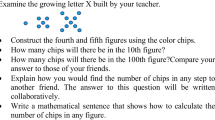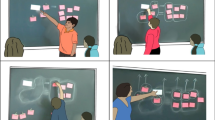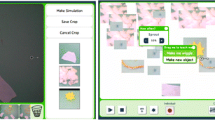Abstract
This paper presents two case studies of learners attempting to make sense of the concept of normal distribution — in particular, why physical phenomena such as height fall into normal distributions. The notion of epistemological anxiety is advanced as being the source of the difficulties learners have in making sense of normal distributions. The framework of Connected Mathematics is used to analyze the learners' coming to understanding of normal distributions and as a source of therapeutic intervention for the epistemological anxiety. As both a symbolizing medium and an aid to analysis, one learner is provided with an object-based parallel modeling language (OBPML) with which the learner can formulate computational hypotheses about the local probability rules that lead to the emergence of a global distribution. Through the investigation, supported by the OBPML, the learner makes connections between the micro-rules of probability and the resultant (macro-) statistical distributions. Conclusions are then drawn about the features of a Connected Mathematics learning environment that enable confrontation with epistemological anxiety and the features of modeling languages that enable learners to conduct a successful probability investigation.
Similar content being viewed by others
REFERENCES
Abelson, H. and diSessa, A.: 1980, Turtle Geometry: The Computer as a Medium for Exploring Mathematics, MIT Press, Cambridge, MA.
Abelson, H. and Goldenberg, P.: 1977, Teacher's Guide for Computational Model of Animal Behavior. LOGO Memo NO. 46, Cambridge, MA.
Ball, D.: 1993, ‘With an eye on the mathematical horizon: Dilemmas of teaching elementary school mathematics’, Elementary School Journal 93(4), 373–397.
Belenky, M., Clinchy, B., Goldberger, N., and Tarule, J.: 1986, Women's Ways of Knowing, Basic Books, New York.
Biehler, R.: 1994, ‘Cognitive technologies for statistics education’, In L. Brunelli and G. Cicchitelli (eds), Proceedings of the First Scientific Meeting of the International Association for Statistical Education.
Borel, E.: 1909, Eléments de la théorie des probabilitiés, Hermann et Fils, Paris.
Brandes, A.: 1996, ‘Elementary school children's images of science’, in Y. Kafai and M. Resnick (eds), Constructionism in Practice: Rethinking Learning and Its Contexts.
Brown, S. I. and Walter, M.I.: 1990, The Art of Problem Posing (2nd ed.), L. Erlbaum Associates, Hillsdale, NJ.
Carey, S.: 1986, ‘Cognitive science and science education’, American Psychologist 41(10).
Cartwright, N.: 1987, In Kruger, L., Daston, L. and Heidelberger, M. (eds) The Probabilistic Revolution, Vol. 2, MIT Press, Cambridge, MA.
Case, R.: 1993, ‘Theories of learning and theories of development’, Educational Psychologist 28(3).
Chipman, S. F., Krantz, D. H. and Silver, R.: 1992, ‘Mathematics anxiety and science careers among able college women’, Psychological Sciences 3, 292–295.
Clement, J.: 1982, ‘Student preconceptions in introductory mechanics’, American Journal of Physics 50(66).
Collins, A. and Brown, J. S.: 1988, ‘The computer as a tool for learning through reflection’, H. Mandl and A. Lesgold (eds), Learning Issues for Intelligent Tutoring Systems, Springer Verlag, New York, pp. 1–18.
Confrey, J.: 1993a, ‘A constructivist research programme towards the reform of mathematics education’, An introduction to a symposium for the Annual Meeting of the American Educational Research Association, April 12–17, 1993 in Atlanta, Georgia.
Confrey, J.: 1993b, ‘Learning to see children's mathematics: Crucial challenges in constructivist reform’, K. Tobin (Ed.), The Practice of Constructivism in Science Education, American Association for the Advancement of Science, Washington, DC., pp. 299–321.
Confrey, J.: (in press), ‘Voice and perspective: Hearing epistemological innovation in students' words’ (Special Issue), N. Bednarz, M. Larochelle and J. Desautels (eds), Revue de sciences de l'education.
Cosmides, L. and Tooby, J.: 1995, ‘Are humans good intuitive statisticians after all? Rethinking some conclusions from the literature on judgment under uncertainty’, Cognition.
Cuoco, A., Goldenberg, P., and Mark, J.: 1995, ‘Connecting geometry with the rest of mathematics’, in House, Peggy A., and Arthur F. Coxford (eds), Connecting Mathematics across the Curriculum. The NCTM 1995 Yearbook, National Council of Teachers of Mathematics, Reston, VA.
Damarin, S. K.: 1995, ‘Gender and mathematics from a feminist standpoint’, in W. G. Secada, E. Fennema and L. B. Adajian (eds), New Directions for Equity in Mathematics Education, Cambridge University Press, New York.
Dantzig, T.: 1969, The Bequest of the Greeks, Greenwood Press, New York.
Daston, L.: 1987, ‘Rational individuals versus laws of society: from probability to statistics’, Kruger, L. Daston, L. and Heidelberger, M. (eds), The Probabilistic Revolution, Vol 1, MIT Press, Cambridge, MA.
Dennis, D. and Confrey, J.: 1993, ‘The creation of continuous exponents: A study of the methods and epistemology of Alhazen and John Wallis’, paper presented at the annual meeting of the American Educational Research Association, April 12–17, 1993 in Atlanta, Georgia.
Dweck, C. S. and Leggett, E. L.: 1988, ‘A social-cognitive approach to motivation and personality’, Psychological Review 95(2), 256–273.
Edwards, L.: 1995, ‘Microworlds as Representations’, Noss, R., Hoyles, C., diSessa A. and Edwards, L. (eds), Proceedings of the NATO Advanced Technology Workshop on Computer Based Exploratory Learning Environments, Asilomar, CA, p. 127–154.
Edwards, L.: 1992, ‘A LOGO microworld for transformational geometry’, Hoyles, C. and Noss, R. (eds), Learning Mathematics and Logo, MIT Press, London, pp. 127–155.
Efron, B.: 1982, The Jacknife, the Bootstrap, and Other Resampling Plans, Philadelphia: Society for Industrial and Applied Mathematics.
Feurzeig, W. and Richards, J.: 1996, ‘Function machines — A visual programming environment for mathematics education-modeling the real world’, Communications of the ACM. August, v38,n8.
Gigerenzer, G. and Hoffrage, U.: 1995, ‘How to improve Bayesian reasoning without instruction: frequency formats’, Psychological Review 102(4).
Gigerenzer, G.: 1987, ‘Probabilistic thinking and the fight against subjectivity’, Kruger, L. Daston, L. and Heidelberger, M. (eds), The Probabilistic Revolution, Vol 2, MIT Press, Cambridge, MA.
Gilligan, C.: 1977, In a Different Voice: Psychological Theory and Women's Development, Harvard University Press, Cambridge, MA.
Goldenberg, E. P., Cuoco, A. and Mark, J.: 1993, ‘Connected geometry’, Proceedings of the Tenth International Conference on Technology and Education., Cambridge, MA, March 21–24, 1993.
Hammer, D.: 1995, ‘Epistemological considerations in teaching introductory physics’, Science Education 79(4), 393–415.
Harel, I.: 1992, Children Designers, Ablex, Norwood, NJ.
Harel, I. and Papert, S.: 1990, ‘Software design as a learning environment’, Interactive Learning Environments Journal 1(1), Ablex, Norwood, NJ, 41–84.
Hoyles, C.: 1985, ‘Culture and computers in the mathematics classroom’, Inaugural lecture, Bedford Way Paper, Institute of Education, University of London, London.
Hoyles, C.: 1991, ‘Computer-based learning environments for Mathematics’, A. Bishop, S. Mellin-Olson, and J. Van Dormolen (eds), Mathematical Knowledge: Its Growth Through Teaching, Kluwer, Dordrecht, 147–172.
Hoyles, C.: 1992, ‘A pedagogy for mathematical microworlds’, Educational-Studies-in-Mathematics v23n(1), pp. 31–57.
Kahneman, D.: 1991, ‘Judgment and decision making: A personal view’, Psychological Science v2,n(3), May 1991, pp. 142–145.
Kahneman, D., and Tversky, A.: 1982, ‘On the study of statistical intuitions’, D. Kahneman, A. Tversky, and D. Slovic (eds), Judgment under Uncertainty: Heuristics and Biases, Cambridge University Press, Cambridge, England, pp. 493–508.
Kahneman, D., and Tversky, A.: 1973, ‘On the psychology of prediction’, Psychological Review 80(4), 237–251.
Kaput, J.: 1989, ‘Notations and representations’, Von Glaserfeld, E. (Ed.), Radical Constructivism in Mathematics Education, Kluwer Academic Publishers, Netherlands, pp. 53–74.
Keller, E. F.: 1993, A Feeling for the Organism: The Life and Work of Barbara McClintock, W.H. Freeman, San Francisco, CA.
Keynes, J. M.: 1921, A Treatise on Probability, MacMillan, London.
Kline, M.: 1972, Mathematical Thought from Ancient to Modern Times, Oxford University Press, New York.
Kolmogorov, A. N.: 1950, Foundations of the Theory of Probability, Chelsea Pub. Co., New York.
Konold, C.: 1989, ‘Informal conceptions of probability’, Cognition and Instruction 6, 59–98.
Konold, C.: 1991, ‘Understanding students' beliefs about probability’, Von Glaserfeld, E. (Ed.), Radical Constructivism in Mathematics Education, Kluwer Academic Press, Netherlands, pp. 139–156.
Konold, C.: 1994, ‘Understanding probability and statistical inference through resampling’, L. Brunelli and G. Cicchitelli (eds), Proceedings of the First Scientific Meeting of the International Association for Statistical Education.
Kruger, L. Daston, L. and Heidelberger, M. (eds): 1987, The Probabilistic Revolution. Vol 1, MIT Press, Cambridge, MA.
Lakatos, I.: 1976, Proofs and Refutations, Cambridge University Press, Cambridge, England.
Lampert, M.: 1990, ‘When the problem is not the question and the solution is not the answer: Mathematical knowing and teaching’, American Education Research Journal, spring, 27(1), 29–63.
Lampert, M.: 1991, ‘Managing the tensions in connecting students inquiry with learning mathematics in school’, D. Perkins, J. Schwartz, and S. Wiske, (eds), Teaching for Understanding in the Age of Technology, Harvard University Press, Cambridge, MA.
Larsen, R. and Marx, M.: 1986, An Introduction to Mathematical Statistics and Its Applications, Prentice Hall, Englewood Cliffs, NJ.
Leron, U.: 1994, ‘Can we follow what we preach: Teaching according to constructivist principles’, CMESG Proceedings, Regina, Sask, Canada.
Leron, U. and Zazkis, R.: 1992, ‘Of geometry, turtles, and groups’, Hoyles, C. and Noss, R. (eds), Learning Mathematics and LOGO, MIT Press, London, pp. 319–352.
Leron, U.: 1983, ‘Structuring mathematical proofs’, American Mathematical Monthly 90(3), 174–185.
Mandinach, E. B. and Cline, H. F.: 1994, Classroom Dynamics. Implementing a Technology-based Learning Environment, Lawrence Erlbaum Associates, Hillsdale, NJ.
M. McCloskey: 1993, ‘Naive theories of motion’, D. Gentner and A. Stevens, (eds), Mental Models, Lawrence Erlbaum, Hillsdale, NJ, pp 299–324.
McLuhan, M.: 1964, Understanding Media, McGraw Hill, New York.
Miller, G. A.: 1956, ‘The magical number seven plus or minus two: Some limits on our capacity for processing information’, Psychological Review 63, 81–97.
Minsky, M.: 1987a, ‘Form and content in computer science’, ACM Turing Award lectures: the First Twenty Years, 1966 to 1985, ACM Press, New York and Addison-Wesley Pub. Co., Reading, MA.
Minsky, M.: 1987b, The Society of Mind, Simon and Schuster Inc., New York.
National Council of Teachers of Mathematics: 1991a, Curriculum and Evaluation Standards for School Mathematics, NCTM, Reston, VA.
National Council of Teachers of Mathematics: 1991b, Professional Standards for Teaching Mathematics, NCTM, Reston, VA.
Nisbett, R.: 1980, Human Inference: Strategies and Shortcoming of Social Judgment, Prentice Hall, Englewood Cliffs, NJ.
Nisbett, R., Krantz, D., Jepson, C., and Kunda, Z.: 1983, ‘The use of statistical heuristics in everyday inductive reasoning’, Psychological Review 90(4), 339–363.
Noss, R.: 1988, ‘The computer as a cultural influence in mathematical learning’, Educational Studies in Mathematics 19(2).
Noss, R. and Hoyles, C.: 1991, ‘Logo and the learning of mathematics: Looking back and looking forward’, Hoyles, C. and Noss, R. (eds), Learning Mathematics and Logo, MIT Press, London, pp. 431–468.
Noss, R.: 1994, ‘Structure and ideology in the mathematics curriculum’, For the Learning of Mathematics, 14(1).
Nozick, R.: 1993, The Nature of Rationality, Princeton University Press.
O'Connor, C. and Michaels, S.: 1993, ‘Aligning academic task and participation status through revoicing: Analysis of a classroom discourse strategy’, Anthropology and Education Quarterly, 24(4).
Papert, S.: 1980, Mindstorms: Children, Computers, and Powerful Ideas, Basic Books, New York.
Papert, S.: 1991, ‘Situating constructionism’, I. Harel and S. Papert (eds), Constructionism, Ablex Publishing Co., Norwood, NJ, (Chapter 1) pp. 1–12.
Papert, S.: 1993, The Children's Machine, Basic Books, New York.
Papert, S.: 1972, ‘Teaching children to be mathematicians vs. teaching about mathematics’, International Journal of Mathematics Education in Science and Technology 3, 249–262.
Papert, S.: 1996, ‘An exploration in the space of mathematics educations’ International Journal of Computers for Mathematical Learning 1(1).
Pea, R.: 1987,‘Cognitive Technologies for Mathematics Education’, Schoenfeld, A. (Ed.), Cognitive Science and Mathematics Education, Erlbaum, Hillsdale, NJ.
Phillips, J.: 1988, How to Think About Statistics, W. H. Freeman, New York.
Piaget, J. and Imhelder, B.: 1951, The Origin of the Idea of Chance, Norton, New York.
Repenning, A.: 1993, AgentSheets: A Tool for Building Domain-Oriented Dynamic, Visual Environments, Ph.D. dissertation, Dept. of Computer Science, University of Colorado, Boulder.
Resnick, M.: 1992, Beyond the Centralized Mindset: Explorations in Massively Parallel Microworlds, Doctoral dissertation, Media Laboratory, MIT, Cambridge, MA.
Resnick, M.: 1994, Turtles, Termites and Traffic Jams: Explorations in Massively Parallel Microworlds, MIT Press, Cambridge, MA.
Resnick, M. and Wilensky, U.: 1993, ‘Beyond the deterministic, centralized mindsets: New thinking for new Sciences’, Presented at the annual conference of the American Educational Research Association, Atlanta, GA.
Resnick, M. and Wilensky, U.: (forthcoming), Diving into Complexity: Participatory Explorations in Non-Deterministic, Decentralized Thinking.
Rotman, B.: 1987, Signifying Nothing: the Semiotics of Zero, MacMillan, Houndmills, Basingstoke, Hampshire.
Rubin, A. D., Rosebery, A., Bruce, B., and DuMouchel, W.: 1989. Getting an early start: using interactive graphics to teach statistical concepts in high school, Proceedings of the Section on Statistical Education, 6–15. Alexandria, VA: American Statistical Association.
Savage, L.: 1954, The Foundations of Statistics, Wiley, New York.
Scheffler, I.: 1991, In Praise of the Cognitive Emotions, Routledge, Chapman and Hall, London.
Schoenfeld, A.: 1991, ‘On mathematics as sense-making: An informal attack on the unfortunate divorce of formal and informal mathematics’, Perkins, Segal, and Voss (eds), Informal Reasoning and Education, LEA, Hillsdale, NJ, 311–343.
Schwartz, J. and Yerushalmy, M.: 1987, ‘The geometric supposer: an intellectual prosthesis for making conjectures’, The College Mathematics Journal 18(1), 58–65.
Sfard. A. and Leron, U.: (in preparation), ‘Just give me a computer and I will move the earth’, On the Effect of Programming on Mathematical Problem Solving. Unpublished Manuscript.
Simon, J. L., Atkinson, D. T. and Shevokas, C.: 1976, ‘Probability and statistics: Experimental results of a radically different teaching methods’, Mathematical Education, November, 733–739.
Simon, J. L. and Bruce, P.: 1991, ‘Resampling: A tool for everyday statistical work’, Chance: New directions for statistics and computing, 4(1), 22–32.
Smith, E. and Confrey, J.: (in press), ‘Multiplicative structures and the development of logarithms: What was lost by the invention of function?’, G. Harel and J. Confrey (eds), The Development of Multiplicative Reasoning in the Learning of Mathematics, Albany: State University of New York Press. pp. 331–360.
Smith, J. P., diSessa, A. A., and Roschelle, J.: 1994, ‘Reconceiving misconceptions: A constructivist analysis of knowledge in transition’, Journal of the Learning Science 3, 115–163.
Steele, C.M. and Aronson, J.: 1995, ‘Stereotype threat and the intellectual test performance of african americans’, Journal of Personality and Social Psychology 69(5), 797.
Steinbring, H.: 1991, ‘The Concept of Chance in Everyday Teaching: Aspects of a Social Epistemology of Mathematical Knowledge’, Educational Studiesw in Mathematics 22(6).
Stroup, W.: 1995, ‘Dynamics and Calculus for the Young Learner’, Connect, May–June
Surrey, J.: 1991, ‘Relationship and Empowerment’, Jordan, J., Kaplan, A., Miller, J.B., Stiver, I. and Surrey, J., Women's Growth in Connection: Writing from the Stone Center, The Guilford Press, New York, pp. 162–180.
Sheila, T.: 1993, Overcoming Math Anxiety, W.W. Norton, New York.
R. K. Thornton and D. R. Sokoloff: 1990, ‘Learning motion concepts using real-time, microcomputer-based laboratory tools’, Am.J. Phys. 58, 858–867.
R. K. Thornton and D. R. Sokoloff: (in press), ‘Assessing and improving student learning of Newton's laws part I: The force and motion conceptual evaluation and active learning laboratory curricula for the first and second laws’, Am.J. Phys..
Tripp, R. T.: 1970, International Thesaurus of Quotations, Harper and Row, New York, pp. 612.
Turkle S., and Papert, S.: 1991, ‘Epistemological pluralism and revaluation of the concrete’, I. Harel and S. Papert (eds), Constructionism, Ablex Publishing Co., Norwood NJ. pp. 161–192.
Tversky, A.: 1973, ‘Availability: A heuristic for judging frequency and probability’, Cognitive Psychology 5, 207–232.
Tversky, A. and Kahneman, D.: 1974, ‘Judgment under uncertainty: Heuristics and biases’, Science 185, 1124–1131.
Tversky, A. and Kahneman, D.: 1980, ‘Causal schemas in judgments under uncertainty’, M. Fischbein (Ed.), Progress in Social Psychology, Erlbaum, Hillsdale, NJ, pp. 49–72.
Tversky, A. and Kahneman, D.: 1983, ‘Extensional vs. intuitive reasoning: The conjunction fallacy in probability judgment’, Psychological Review, 90(4) 293–315.
von Glaserfeld, E.: 1987, ‘Preliminaries to any theory of representation’, C. Janvier (Ed.), Problems of Representation in Mathematics Learning and Problem Solving, Erlbaum, Hillsdale, NJ, pp. 215–226.
von Winterfeldt, D. and Edwards, W.: 1986, Decision Analysis and Behavioral Research, Cambridge University Press, Cambridge, England.
Walkerdine, V.: 1989, Counting Girls Out, Virago, London.
Wilensky, U.: 1991, ‘Abstract meditations on the concrete and concrete implications for mathematics education’, I. Harel and S. Papert (eds), Constructionism, Ablex Publishing Corp., Norwood NJ.
Wilensky, U.: 1993, Connected Mathematics: Building Concrete Relationships with Mathematical Knowledge, Doctoral dissertation, MIT Media Laboratory, Cambridge, MA.
Wilensky, U.: 1995a, ‘Learning probability through building computational models’, Proceedings of the Nineteenth International Conference on the Psychology of Mathematics Education, Recife, Brazil, July 1995.
Wilensky, U.: 1995b, ‘Paradox, programming and learning probability: A case study in a connected mathematics framework’, Journal of Mathematical Behavior 14(2).
Wilensky, U.: 1995c, ‘Mathematics as a way of connecing’. Paper presented at the Proceedings of the Boston Forum for Science Education for Future Generations under the auspices of The American Academy of Arts and Sciences.
Wilensky, U.: 1996 ‘Making sense of probability through paradox and programming’, Y. Kafai and M. Resnick (eds), Constructionism in Practice: Rethinking Learning and Its Contexts.
Wilensky, U.: 1996, ‘Modeling rugby, kick first, generalize later?’, International Journal of Computers for Mathematical Learning 1(1).
Wilensky, U.: (forthcoming), ‘GPCEE—an extensible microworld for exploring micro-and macro-views of gases’, Manuscript submitted for publication.
Author information
Authors and Affiliations
Rights and permissions
About this article
Cite this article
Wilensky, U. What is Normal Anyway? Therapy for Epistemological Anxiety. Educational Studies in Mathematics 33, 171–202 (1997). https://doi.org/10.1023/A:1002935313957
Issue Date:
DOI: https://doi.org/10.1023/A:1002935313957




